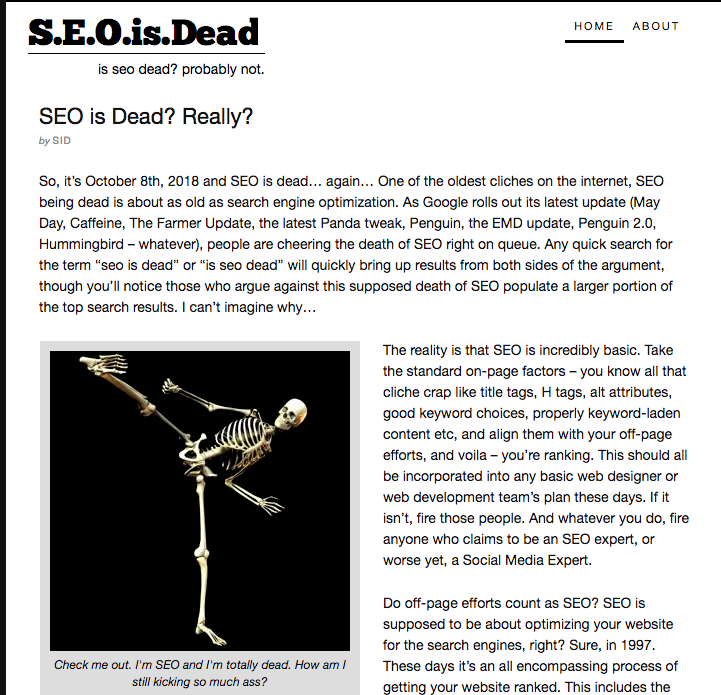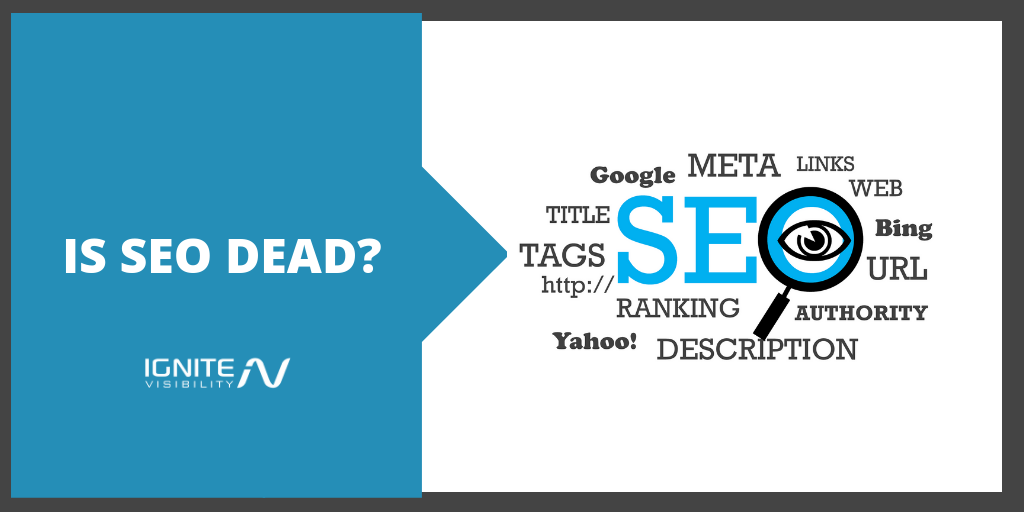More than 90% of online experiences begin with a search engine, with Google receiving over 63,000 searches per second on any given day.
So, this begs the question—is SEO dead? Or…is SEO real?
Well, it’s more of a moving target.
What do I mean by that? Read on to find out!
https://hookagency.com/is-seo-dead/
The Million Dollar Question—Is SEO Dead?
In short, no. In fact, SEO is alive and well.
People are still searching. “Googling” something is still a thing.
And that means every time someone searches for something related to your industry, you need to be right there in the search results.
And how do you get there? Through SEO.
But despite the logic behind it, every year brings a new wave of SEO naysayers.
And for years on end, people have been harking about the death of SEO.

It’s a question that’s raised repeatedly, but let me ask you this: If SEO were truly dead, would we be seeing stats like these?
- 51% of all website traffic comes from organic search.
- Over 40 percent of revenue is captured by organic traffic.
- More than 75% of B2B traffic comes from organic and paid search.
- On the first page of Google alone, the first five organic results account for nearly 68% of all the clicks.
Not only that, but it seems most businesses are still on board with SEO, with companies spending more than $65 billion on SEO each year.
So, why do so many people still question—is SEO real or is SEO dead?
This claim is based largely on the specter of mounting algorithmic updates, the advent of personalized search, and the integration of social usage data signals.
Maybe this is the more appropriate question we should be asking—is SEO still relevant? It has definitely changed.
The way Google displays results has changed. The number of devices used—and how to optimize for them—has changed. And the rise of social has changed how we approach SEO.
But even with these updates, there is always room for optimizing a website, and SEO is perpetually evolving along with the algorithm updates, changes in technology, and the user experience.
And though none of them have replaced the need for traditional SEO, they have changed how we approach it.
Let’s take a look.
How Google Has Transformed SEO
Google remains the dominant force in all things search-related.
It commands the majority of search market share—averaging a net share of 74.5% in 2017—and is users’ preferred search platform.
So it makes sense that when marketers talk SEO, they strategize with Google in mind.
But Google’s been through its fair share of changes over the years, and not all of them have had a positive effect on SEO.
Namely:
- Google has more ads above the fold than ever before.
- Google is displaying more information in the knowledge graph.
- Putting more images and more videos in the search results.
All of these changes to paid ads and SERP layout mean that organic listings have been driven lower down the page.
Beyond that, the sheer impact the internet has had on businesses and how people search means that competition is fiercer than ever.
As of 2016, Google was aware of 130 trillion websites—and you can be that number’s only increased over the past few years.
But really, that just means proper SEO is more important than ever.
Because those that do implement killer SEO strategies and land themselves on page one of the SERPs will find that a.) a lot of people ignore the paid ads at the top anyways, and b.) sales will see a very notable increase.
Sites listed on the first page get 91.5% of the traffic share, so make sure you’re not ignoring your SEO best practices.
Is SEO Dead? No, It’s Just One Part of the Bigger Picture
Perhaps the biggest change in the SEO landscape has been that it’s no longer a standalone marketing strategy.
Instead, It’s become just one channel within the larger marketing mix.
It used to be enough to choose a few keywords and practice correct on-page optimization.
And that’s still important. But these days, It should be an element of your digital marketing strategy; it can’t be the whole thing.
Depending on your industry, SEO Should be somewhere between 20%-60% of your website strategy.
Remember how 51% of all traffic comes from organic search?
That leaves half of web traffic we haven’t even touched on:
Well, stats show that on average, the remainder comes from 10% paid search, 5% social, and 34% from all other sources.
For you, that means you should have a good mix of sources and mediums sending traffic to your website.
Those elements should be:
- Paid search
- Email marketing
- Social media
- Other websites that your demographic is on sending referral traffic
- Direct traffic from brand
SEO should be a big part. Should be continually getting bigger and bigger as far as the amount of traffic your site receives
Is SEO Dead? No, and Here’s How to Rank Well in Google
The good news is, some old SEO rules still apply.
At Ignite, for example, we’re up over 100% year over year for SEO traffic. We get more traffic every single month.
How? By continuing to focus on the most important terms. By continue to scale our content and refresh old pages to keep those terms fresh.
Beyond that, we continue to focus on new and innovative things that are happening in SEO.
That’s all standard, on-page practice.
And yes, that’s all extremely important in the new wave of SEO. But equally important now is the value you deliver on the page.
You can’t rely on a short piece of general, keyword-optimized text to rank anymore.
Instead, you need to work on building on providing valuable, in-depth content, a strong brand and value proposition, an optimized website and strong link profile that all work together.
That value then has to extend to your email, social and PPC presence.
You’ll also want to monitor your technical SEO. While this may not be on the top of every marketer’s priority list, technical SEO issues can really hurt your site’s SEO in the long run.
To ensure it’s not an issue for you, triple check that your site is 100% optimized for mobile. You’ll also want to see how quickly your site loads. Speed tools like WebPageTest.org can be a lifesaver in this case.
But when it comes to the question—is SEO still relevant— it requires more than a well-rounded strategy. It means keeping up with SEO demand and adapting to changes as well.
AMP, the Knowledge Graph, and Other New Features for SEO
Don’t be afraid to install newer features like AMP where appropriate.
AMP, which stands for Accelerated Mobile Pages, is an open-source program from Google designed to make mobile pages load almost instantaneously.
Installing it on pages was especially useful for media sites, as it allowed them to display pages in the carousel section of mobile searches (which appears at the very top of the results).
But it’s benefit for websites across the board lies, of course, in its quick load time.
In terms of SEO, page speed matters. It means a better user experience, which translates to a higher rank from Google.
And, according to research sponsored by Google, pages that use AMP leads to an average of a 2X increase in time spent on page.
Another way to make sure your page stays prominent in the SERPs?
Shoot for the Knowledge Graph.
The Knowledge Graph is the huge side window that appears in the results, generally after a question phrase.
Example—who is Nikola Tesla? Google will serve up this result:
For more on how to get your page ranking in the Knowledge Graph, check out my full article here.
There are plenty of other ways to make sure you SEO is evolving to meet today’s standards, including the shift towards international SEO.
Some countries literally do not have enough search results available for certain keywords—which represents a huge opportunity for those brands decide to implement international SEO.
SEO, Voice Search, and Digital Assistants
No conversation about modern SEO can ignore voice search and digital assistants.
Quite simply, they represent the future of SEO demand.
Remember when smartphones were a big deal? They’re not even cool anymore. They’re just part of our lives.
That’s where digital assistants are headed.
As of January 2018, there were an estimated 1 billion voice searches per month. And by 2021, it’s predicted that 5 billion of searches will be done by voice.
Smart marketers know to stay on top of the trend—before they fall too far behind.
In this case, staying on top means changing the way you approach SEO and keywords.
No longer are short-tail, stilted searches enough. Now, voice searches are conducted primarily with question phrases.
So instead of “trampoline park,” people are asking “where can I find a trampoline park near me?”
Increasingly, people are interacting with their digital assistants as they would a conversation with a human.
This means your keyword focus needs to switch to long-tail keywords and search queries, and your content needs to adopt a more conversational tone that search engines (and their Natural Language Processors) can pick up on.
It means paying special attention to Featured Snippets. These are the quick answers to question search queries that appear above the number one spot in Google (position 0), and are often read as results in voice searches.
Again, that means optimizing your content for questions. Make your H1s and H2s into question.
It also means placing an even bigger emphasis on local SEO and “near me” searches.
Even if you aren’t a traditionally local shop, you still need to make sure you properly claim and fill out your Google My Business page and all other online directories, and are collecting as many online reviews as possible.
So the question here is this—how do these traditional components and emerging technologies come together in one cohesive strategy?
The good news is that good companies will be way ahead of these new technologies. They’ll be anticipating how developments like digital assistants will affect the SEO landscape, and recognize any new opportunities it presents.
They’re the ones who have already launched strategies that include voice search and made their presence known on digital assistants.
They’re also the ones that know that more searches represent more opportunity—whether it be through voice or text.
The more searches performed, the more we can personalize, segment, cookie, and ultimately better refine our digital marketing strategies.
Wrapping Up
Traditional SEO is changing. There’s no doubt about it. But, is SEO dead? No. Far from it.
The practices that used to put you on page one no longer guarantee success, and staying on top requires brands and marketers to adapt.
As always, the only constant is change. And you can bet SEO will continue to change and evolve as the years unfold.
But the bottom line is this—if SEO is dying, it’s not going out without a fight.



